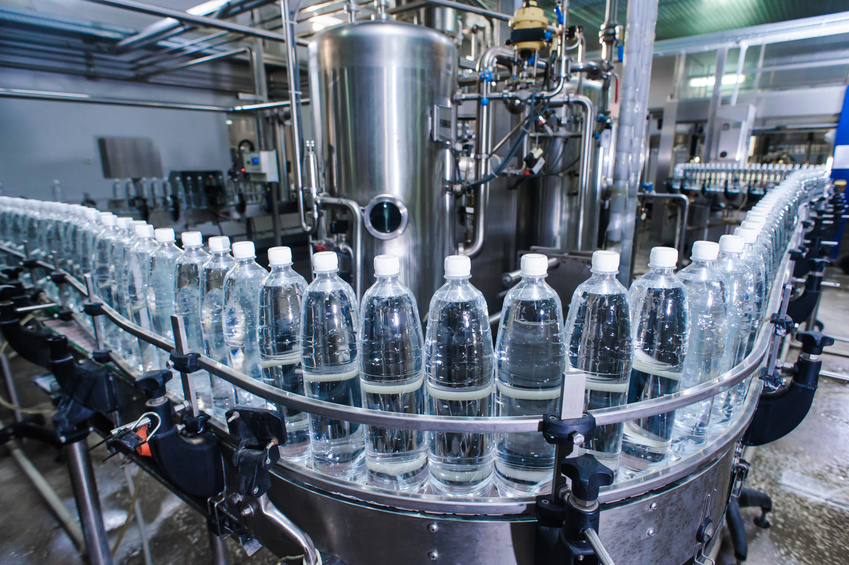Packaging is essential for the distribution and storage of food. Its main function is to maintain the quality of food in terms of freshness and the absence of pathogens. Packaging material are made of paper, glass, metal or plastic. Often different packaging materials are combined to provide better protection. Its purpose ranges from protective abilities like shielding against microbes, providing mechanical barriers for gas or moisture (to prolong the freshness) to easier storage (it is easier to store cubic packages) and providing written information to customers (producer, content and special storage information for consumers) [1,2]. Incorporating engineered nanomaterials may improve existing packaging material and can also create novel, smart packaging solutions.

Plastic bottles in filling plant ©Mikhail – stock.adobe.com
Nanotechnology in food packaging focuses on four different aspects:
(1) Improved packaging stability, (2) improved barrier functionality by reducing gas exchange, (3) antimicrobial properties and (4) smart packaging for communicating with the consumer. However, currently, in the EU the engineered nanomaterials titanium nitride, zinc oxide, silica and carbon black are allowed to be used in food contact materials. Titanium nitride and zinc oxide are the only food packaging materials which are defined as nanoparticles in EU regulations while silica and carbon black are described as substances with particles in the nm range without the term “nanoparticle” [3].
In Asia and the US silver iso allowed in food packaging.
Improved packaging stability
Inert nanoscale fillers such as silica nanoparticles, titanium dioxide, titanium nitride particles, chitin or chitosan are integrated into the polymer matrix or used as coating to improve the plastic packaging materials’ stability by advancing the materials’ stiffness and mechanical strength [4-7]. In addition, silica and titanium dioxide nanoparticles are able to enhance the hydrophobic properties of paper-based packaging materials and a combination of clay and starch nanocomposite films improves the tensile strength while being more biodegradable [1,8].
Improved Barrier functionality
Degassing of beverages can be prevented by integrating silicon dioxide nanoparticles into the polymer matrix as this reduces the diffusion of the vaporised water or gas through the packaging material [6,8]. Likewise, a nanoclay (which is not used in Europe) coating of the polymer (nylon 6) prevents the oxygen uptake into beer beverages [1]. Usage of titanium dioxide nanoparticles prolongs the freshness and shelf-life of fruit and vegetables as oxygen or ethylene are deactivated via the UV induced photocatalytic effect of the nanoparticles [8].
Antibacterial Properties
A variety of nanoparticles confer antimicrobial properties to plastic packaging materials thereby preventing the growth of food damaging microorganisms: silver, copper, various metal oxides (e.g. titanium dioxide, zinc oxide or copper oxide) and carbon nanotubes [4,9]. Mode of action behind the antimicrobial properties of the nanomaterials are the release of ions (e.g. silver, copper) and/or the production of reactive oxygen species through photocatalytic effects (e.g. titanium dioxide, zinc oxide) [6,7]. Silver nanomaterials are most prominently used in packaging materials due to their broad efficiency against various bacteria in the form of pure silver or silver composites with zeolites and polylactic acid (e.g. as coating of baby mugs [1,8].
Smart packaging
Smart packaging describes the ability of the material to monitor the quality of food. This includes the detection of chemicals or of temperature changes. Moreover smart packaging can communicate the current situation of the food to the consumer by using indicators or sensors [10, 11]. One of the first examples for smart packaging materials are titanium dioxide nanoparticle-based sensors or specific metals which indicate gasses or a shift in the pH value by a colour change. In case of titanium dioxide, the colour can change from colourless to blue in the presence of oxygen and shows that product had been opened [4,5]. In addition to oxygen, temperature is very crucial for the freshness of food. The combination of silver-gold nanoparticles created a temperature sensor which could change its colour from red to yellow to green, when for example the cold chain has been interrupted. To indicate the freshness of packed meat, packaging material was coated with nano silver. In the presence of sulphides which are decay products of meat spoilage, silver is oxidized to silver sulphide resulting in a black colour [5]. While smart packaging possesses a huge potential, all the described examples are not allowed in the EU, but in the US.
Migration of nanoparticles into the food – Risk for the consumer?
In general, there is a potential risk that nanomaterials will migrate from packaging to food. For nano silver there is a small possibility of nanomaterial migration from PET bottles into the liquid. While one study showed an increased release over time, several other studies could not link the detected silver to nanoparticles. For other nanoparticles like nanoclays, titanium nitride or titanium dioxide, there are both studies for PET bottles, which could show nanoparticle migration as well as those which could not find migration [12,13].
So far five nanomaterials have been approved by the European Food Safety Authority (EFSA) for food contact materials as they showed no safety concern regarding human health: titanium nitride, selenium nanoparticle, silica and zinc oxide. For the fifth compound, montmorillonite clay, which consists of silica and alumina, a mass transfer of nanoparticles below or at the limit of detection had been detected [14-18,19]. Nevertheless a total risk assessment of migrated nanomaterial regarding human health is very complex because the interactions of released nanoparticles with food or the passing of the gastrointestinal tract have not been studied well enough [12]. Jokar et al. developed a simplified risk assessment for nanomaterials in food and food packaging. The risk for human health is increased if the nanomaterial is able to migrate and if the nanomaterial remains in its nanoform (as shown in the figure).
Legal situation
 In 2009, 13 countries agreed on studying long-term effects of nanotechnology in food and food packaging regarding human health safety. In case of nanoparticles in food contact material the Plastic Food Contact Materials Regulation or the Active and Intelligent Materials and Articles Regulation are defining what is allowed. The only nanomaterials, which are listed in the regulations with focus on food contact materials are titanium nitride, silicon dioxide, kaolinite (an aluminium-silicon compound) and zinc oxides. [3,20-21].
In 2009, 13 countries agreed on studying long-term effects of nanotechnology in food and food packaging regarding human health safety. In case of nanoparticles in food contact material the Plastic Food Contact Materials Regulation or the Active and Intelligent Materials and Articles Regulation are defining what is allowed. The only nanomaterials, which are listed in the regulations with focus on food contact materials are titanium nitride, silicon dioxide, kaolinite (an aluminium-silicon compound) and zinc oxides. [3,20-21].
A total overview on all regulations and guidance can be found on the webpage of the EFSA. Before nanomaterials in the EU are considered to be approved, they have to be authorized by the EFSA. As mentioned before, in food packaging this is only the case for titanium nitride, selenium nanoparticle, silica, montmorillonite clay, and zinc oxide. After the authorization by the EFSA the nanomaterials have to be included to the regulation by the EU commission. Nevertheless, the legal framework regarding nanoparticles differs among countries. In the USA nanoparticles are in general allowed as long as their concentration is below the defined limitation, while the EU has stricter regulations. One of the most prominent examples, nano silver, which is common in the USA, Asia or Australia, cannot be combined with plastic in the EU. This is even more important when the plastic is used as food packaging and can come into contact with food [3,4].
Nanotechnology offers great opportunities for packaging materials. Packaging can become stronger, lighter, and less fragile. Moreover, the antimicrobial properties of some nanoparticles prolong the freshness of food and nano sensors display the condition of the food. Therefore, many companies started to incorporate nanomaterials in their packaging. Nevertheless, nanoparticles may migrate from the packaging into the food and thereby be a potential health threat.
Literature
- Bumbudsanpharoke, N et al. (2015), J Food Sci, 80(5): R910-923.
- Luykx, DMaM et al. (2008), Journal of Agricultural and Food Chemistry, 56(18): 8231-8247.
- Commission Regulation (EU) No 10/2011 of 14 January 2011 on plastic materials and articles intended to come into contact with food. OJ L 12, 15.1.2011, p. 1–89.
- Peters, RJB et al. (2016), Trends in Food Science & Technology, 54 155-164.
- Mihindukulasuriya, SDF et al. (2014),Trends in Food Science & Technology, 40(2): 149-167.
- Yemmireddy, VK et al. (2015), Food Control, 57 82-88.
- Espitia, PJP et al. (2012), Food and Bioprocess Technology, 5(5): 1447-1464.
- Popov, V et al. (2015), Green Processing and Synthesis, 4(2): 125-131.
- Gialleli, A-I et al. (2016), Innovative Food Science & Emerging Technologies, 33 416-421.
- Silvestre, C et al. (2011), Progress in Polymer Science, 36(12): 1766-1782.
- Singh, T et al. (2017), Front Microbiol, 8 1501.
- Jokar, M et al. (2017), Food Additives and Contaminants Part a-Chemistry Analysis Control Exposure & Risk Assessment, 34(3): 434-450.
- Fortunati, E et al. (2012), Carbohydrate Polymers, 90(2): 948-956.
- EFSA Panel on Food Contact Materials, Enzymes, Flavourings and Processing Aids (2012), EFSA Journal, 10(3): 2641, 8 pp.
- EFSA Panel on Food Contact Materials, Enzymes, Flavourings and Processing Aids (2015), EFSA Journal, 13(4): 4063, 9 pp.
- EFSA Panelon Food Contact Materials, Enzymes, Flavourings and Processing Aids, Silano, V et al. (2018), EFSA Journal, 16(1):5115, 7 pp.
- EFSA Panel on Food Contact Materials, Enzymes, Flavourings and Processing Aids (2014), EFSA Journal, 12(6): 3712, 7 pp.
- EFSA Panel on Food Contact Materials, Enzymes, Flavourings and Processing Aids (2016), EFSA Journal, 14(3): 4408, 8 pp.
- EFSA Panelon Food Contact Materials, Enzymes and Processing Aids, Silano, V et al. (2019), EFSA Journal, 17(1): e05552, 8 pp.
- Takeuchi, MT et al. (2014), Food Res Int, 64 976-981.
- Commission Regulation (EC) No 450/2009 of 29 May 2009 on active and intelligent materials and articles intended to come into contact with food. OJ L 135, 30.5.2009, p. 3–11.
 >
>